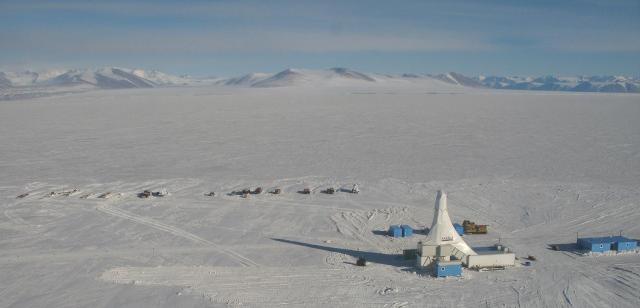Feb 23 2016
Results from a new climate reconstruction of how Antarctica’s ice sheets responded during the last period when atmospheric carbon dioxide (CO2) reached levels like those expected to occur in about 30 years, plus sediment core findings reported in a companion paper, suggest that the ice sheets are more vulnerable to rising atmospheric CO2 than previously thought.
 The National Science Foundation’s Antarctic drilling program (ANDRILL) provides sediment core data to allow researchers to reconstruct the history of Antarctica’s ice sheets. Two recent studies including a core analysis plus past climate modeling suggest the ice sheets are more vulnerable to higher atmospheric CO2 levels than previously thought. Courtesy NSF/ANDRILL
The National Science Foundation’s Antarctic drilling program (ANDRILL) provides sediment core data to allow researchers to reconstruct the history of Antarctica’s ice sheets. Two recent studies including a core analysis plus past climate modeling suggest the ice sheets are more vulnerable to higher atmospheric CO2 levels than previously thought. Courtesy NSF/ANDRILL
Details appear in two papers in the current Proceedings of the National Academy of Sciences.
Researchers led by Edward Gasson and Robert DeConto at the University of Massachusetts Amherst, with colleagues at Pennsylvania State University and GNS Science, New Zealand, report results of a climate and ice sheet modeling study, while Richard Levy of New Zealand and colleagues with the National Science Foundation’s Antarctic drilling program (ANDRILL), report their analyses of a 3,735-foot sediment core from McMurdo Sound to reconstruct the Antarctic ice sheets’ history.
The authors state that taken together, the findings highlight that large changes in the Antarctic ice sheets may be possible at lower levels of atmospheric carbon dioxide than previous studies have shown.
Gasson explains that climate researchers have long sought to create a model that simulates conditions similar to those experienced during the early to mid-Miocene, as established by sediment core data. This was likely the last time atmospheric CO2 levels were slightly higher, at 500 parts per million (ppm), than the 400 ppm level reached just last year, and global average temperatures were about 3 to 4 degrees Celsius higher than today.
But this does not mean that melting Antarctic ice sheets will raise global sea levels immediately, the researchers say. “The ice sheets will take hundreds of years to respond, so although CO2 may be at the same level as during the Miocene in the next 30 years, it doesn’t mean that they will melt in 30 years,” Gasson adds.
Understanding how the huge Antarctic ice sheets will respond to such warming is a major goal for climate scientists. Gasson says, “We know that the Antarctic ice sheet will eventually melt if we burn all known fossil fuel reserves, raising sea levels by over 100 feet. What these two studies show is that the Antarctic ice sheet is also vulnerable to much lower levels of carbon dioxide than we thought possible before.”
Previous attempts to simulate Antarctic ice sheet retreat have been inadequate because despite direct geological evidence that large swings in the extent of ice sheets driven by small changes in atmospheric CO2 occurred, it was difficult for computer simulations to model them.
Gasson and colleagues’ model includes three key new strategies that improve the simulation. In particular, Gasson and colleagues use a component that captures feedbacks between the ice sheet and climate better than before. The UMass Amherst-led modeling team authors point out that their work “largely resolves the discrepancy between geological records and ice sheet models that had previously existed.”